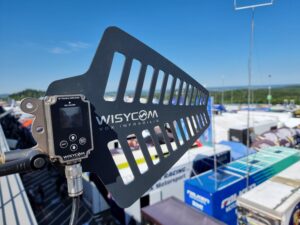NÜRBURG, RHINELAND-PALATINATE, GERMANY— TV Skyline, one of Germany’s leading broadcast providers, supports a wide range of high-profile productions across Europe and beyond. From Bundesliga and Champions League matches to large-scale entertainment and music events, the company is well-versed in complex live broadcasting. For many years, TV Skyline has helped deliver broadcast coverage at the iconic ADAC 24-Hour Race at the Nürburgring, also known as ADAC RAVENOL 24h Nürburgring. Renowned for its technical challenges and vast terrain, the event requires a robust and highly flexible RF system, making Wisycom the obvious choice.

The historic ADAC 24-Hour Race at Nürburgring is one of the world’s most legendary racing events. Starting in the afternoon on a Saturday and concluding 24-hours later, the annual endurance race garnered around 300,000 attendees on-site this year alone. The track, reaching almost 22 kilometers long with nearly 300 meters in elevation change, holds around 120 cars in participation—ranging from amateur to major teams—all sharing only about 30 pit spaces. “It’s a logistical beast,” says Daniel Jäger, Sound Engineer, TV Skyline. With unpredictable weather, dense crowds and a tight race environment, the Nürburgring presented significant RF and operational hurdles. “It’s more like a motorsport festival,” says Alexander Wenke, TV Skyline’s OB Truck Manager. “For 24-hours, the drivers and crew need to perform without fail.”
TV Skyline brought two OB vans to the site: one to handle the international feed and another for national coverage in Germany. The main OB van managed approximately 70 cameras stationed along the track, with about 100 microphones capturing audio. Given the size of the area, a conventional wireless setup wasn’t an option. “That’s why Wisycom’s fiber-based RF solutions were essential,” says Jäger. “It allowed us to connect multiple antennas across vast distances and operate as if it’s one big RF zone. Otherwise, we would have needed individual receivers everywhere, which is not efficient.”
The company deployed Wisycom’s MFL fiber links, MRK980 receivers, MTK952 transmitters, MTH400 handhelds, MPR30 IEM belt packs and RPU500 portable transmitters. For camera receivers, they used MCR42 and MCR54 units, providing a backup layer to ensure audio integrity. “Each of the two camera presenters had a sound technician, who each mixed their respective presenter and guest microphones on location and sent it to the OB van via RPU500. This eliminated latency and ensured the talent could hear themselves, which is crucial in the noisy pit lane,” Jäger explains. “While this could be made easier by just using the back-up receivers on the radio cameras, the moderators would not be able to hear themselves due to the latency.”
Wisycom’s unique ISO frequency technology was also critical. “It let us transmit the same frequency across multiple antennas, so our talent can roam freely without losing signal or needing to switch packs,” adds Jäger. “It was seamless.”
The Nürburgring environment is notoriously hostile to wireless systems. The pit lane alone spans nearly 400 meters, with concrete and metal structures throughout the facility, all while dozens of teams run their own RF gear with no official coordination. “There’s no clear RF spectrum,” notes Jäger. “Some amateur teams bring outdated or unregulated gear, and the environment changes daily. What worked Tuesday might be unusable by Thursday. Wisycom handles it with resilience and headroom.”
Stefan Thenmayer, Head of Audio at TV Skyline and A1 for the race, adds, “Wisycom has an extremely solid build. Even if you make a small mistake—say, a faulty cable, the system keeps running without noticeable failure. That’s invaluable in a live environment like this.”
Despite the scale and complexity, the TV Skyline crew, including 18 engineers on-site, deployed the system with precision. “We have it down to a process now,” says Thenmayer. “We use Google Maps to plan antenna placements, coordinate what’s needed with the team and adapt to whatever the broadcast station requires. The system is versatile enough to work over both fiber and RF cable, which makes setup much easier.”
As Wisycom users for years, TV Skyline’s relationship with the brand continues to grow, as the system has continuously set them up for success. “Wisycom is incredibly flexible,” says Wenke. “We can integrate handhelds, IEMs and receivers with analog transmitters from other brands. That kind of compatibility is unique.”
While the user interface may be more advanced than some competing systems, Thenmayer says it’s a worthy tradeoff. “Sure, it takes a bit more expertise to navigate, but you get so much more out of it. For complex shows, you need that control.” Jäger agrees, noting that recent internal improvements have made frequency management even easier for junior engineers. “We’ve created a frequency chart and built it into the devices. So, less experienced users can still work effectively without overthinking the RF setup.”
Ultimately, Wisycom proved to be the backbone of this very technically demanding production. “For the entire event, we trusted Wisycom to deliver, and it did,” says Thenmayer. “That’s what matters most.”
